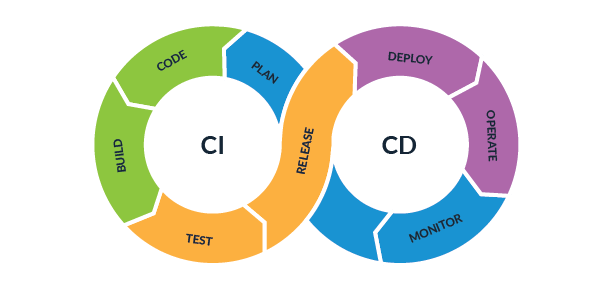In the ever-changing world of software development, staying ahead of the competition means embracing new technologies. One such technology is Continuous Integration and Continuous Delivery (CI/CD). CI/CD can make a huge difference for testers when it comes to streamlining their testing processes. By precisely integrating CI/CD into their workflows, testers can gain a major advantage when it comes to efficiently and accurately testing software applications. In this blog post, we’ll discuss the role of CI/CD for testers and how it can help them improve their workflows.
The Importance of Streamlining Testing Processes
In the fast-paced world of software development, time is of the essence. Deadlines loom, expectations are high, and the pressure to deliver flawless products is intense. Amidst this chaos, testers play a critical role in ensuring the quality of software before it reaches the hands of end-users. However, their effectiveness can be hindered by cumbersome testing processes that slow them down and create unnecessary bottlenecks.
That is why streamlining testing processes is crucial. By optimizing workflows and eliminating inefficiencies, testers can focus their time and energy on what truly matters – ensuring that the software meets the highest standards of quality. Streamlining testing processes is not just about improving productivity, it is about empowering testers to do their best work and ultimately deliver exceptional products.
When testing processes are streamlined, testers can seamlessly integrate into the software development lifecycle (SDLC) and work hand in hand with developers. They can provide timely feedback, identify and address issues early on, and collaborate effectively to resolve them. This close collaboration not only fosters a sense of teamwork but also leads to improved communication and understanding between testers and developers.
Furthermore, streamlining testing processes enables testers to be more proactive in their approach. They can anticipate potential risks and challenges, and take proactive steps to mitigate them. By catching issues early on, testers can prevent them from escalating and causing major disruptions later in the development cycle.
Ultimately, streamlining testing processes allows testers to become more efficient and effective in their roles. It enables them to devote more time to the tasks that require their expertise and judgment, such as designing comprehensive test plans, executing test cases, and analyzing results. By eliminating redundant and manual tasks, testers can focus on higher-value activities that truly add value to the development process.
What is CI/CD?
In the fast-paced world of software development, time is of the essence. And that’s where CI/CD comes in, like a superhero swooping in to save the day. CI/CD, short for Continuous Integration/Continuous Delivery (or Continuous Deployment), is a set of practices that enable developers to automate and streamline the process of building, testing, and deploying their code.
But what does that really mean for testers? Well, it means a world of opportunity to improve their workflows and efficiency. CI/CD essentially allows for a seamless integration of code changes, enabling teams to continuously deliver updates and improvements to their software. Gone are the days of manual testing and arduous deployments. With CI/CD, testers can focus on what they do best – finding bugs and ensuring the software meets the highest quality standards.

CI/CD works by automating the build and test process. Whenever a developer makes changes to the code, CI/CD tools automatically trigger a series of tests to ensure that the code is functioning as expected. These tests can include unit tests, integration tests, and even performance tests. Once the code passes all the tests, it is automatically deployed to a testing environment, ready for further testing by the QA team.
By implementing CI/CD, testers can say goodbye to the frustration of waiting for developers to complete their work and hand it over for testing. They can work hand in hand with the developers, collaborating and sharing feedback in real-time. This level of collaboration not only improves communication but also fosters a sense of camaraderie and teamwork among the development and QA teams.
In addition to improving workflows and collaboration, CI/CD also allows for faster feedback loops. Testers can quickly identify and report issues, enabling developers to fix them before they become critical. This reduces the time and effort spent on fixing bugs and ultimately leads to a higher quality end product.
The Role of CI/CD in Testing
As technology continues to evolve and become more complex, software testing is becoming more critical than ever before. However, traditional testing processes can be time-consuming, and as a result, many organizations are turning to Continuous Integration and Continuous Delivery/Deployment (CI/CD) to streamline their testing workflows.
Precisely speaking, CI/CD is an approach that focuses on automating the software delivery pipeline. It involves continuous testing, integration, and deployment of code changes to ensure that applications are always functioning as intended. For testers, this means that they can quickly identify issues and resolve them before they escalate, saving time and resources in the long run.
One of the essential roles of CI/CD in testing is ensuring that code changes are thoroughly tested before they are released to the end-users. With the help of automated tests, teams can identify issues much faster than with manual testing. In turn, this allows developers to focus on addressing these issues and improving code quality.
CI/CD also plays a crucial role in enabling faster releases. The process allows for frequent and automated releases, reducing the time-to-market for new features and functionality. As a result, testers can spend less time waiting for releases and more time focusing on identifying and addressing potential issues.
Implementing CI/CD in testing also helps to foster a culture of collaboration. It brings together teams from different departments and encourages them to work together towards a common goal. In turn, this promotes open communication and a sense of shared responsibility for delivering high-quality software.
Benefits of Using CI/CD for Testing Processes
In the fast-paced world of software development, it is crucial for testers to keep up with the ever-increasing demands and expectations. This is where Continuous Integration/Continuous Deployment (CI/CD) comes into play. CI/CD integration for testing offers numerous benefits that can revolutionize the way testers work and improve their workflows. Let’s explore some of these benefits:
Improved Efficiency: With CI/CD, testers can automate the entire testing process, reducing manual effort and allowing for faster and more frequent releases. This not only saves time but also ensures that testing is conducted consistently and accurately, resulting in higher efficiency and productivity.
Enhanced Collaboration: CI/CD promotes better collaboration between testers, developers, and other stakeholders. Through the continuous integration and deployment of code changes, testers can work closely with developers to identify and fix issues early on. This collaboration leads to better communication, increased transparency, and ultimately, a more robust product.
Increased Test Coverage: By automating tests through CI/CD, testers can expand their test coverage. With the ability to run tests on various platforms, browsers, and devices, testers can ensure that their product works seamlessly across different environments. This broadens the scope of testing and improves the overall quality of the software.
Faster Time to Market: CI/CD enables testers to catch and address issues early in the development cycle. By continuously testing and deploying code changes, potential bugs and glitches can be detected and resolved promptly. This speeds up the development process, allowing for faster releases and shorter time to market.
Continuous Feedback Loop: CI/CD provides testers with a constant feedback loop, allowing them to continuously improve their testing processes. Testers can gather valuable insights from the automated test results and use this data to identify patterns, optimize test cases, and enhance overall test strategy. This iterative feedback loop ensures continuous learning and improvement, resulting in higher-quality software.
Common Challenges Faced by Testers and How CI/CD Can Help
As testers, we all know the struggle of keeping up with the demands of a constantly evolving software development cycle. From finding bugs to verifying fixes, the job can be challenging and time-consuming. The pressure to deliver high-quality software is always looming, and testers often find themselves caught in a cycle of tedious manual testing.
One of the biggest challenges that testers face is the lack of integration between different stages of the software development process. Traditional software development cycles precisely involve separate stages of development, testing, and deployment. This means that testing happens at the end of the process, and testers have limited time to identify and report issues.
However, with the introduction of CI/CD, testers can be integrated into the development process. CI/CD stands for Continuous Integration/Continuous Deployment, and it is a methodology that emphasizes the automation of software development, testing, and deployment. With CI/CD, testing happens at every stage of the development process, ensuring that bugs are identified and fixed early.
Another challenge that testers face is the complexity of testing environments. As software becomes more complex, it can be challenging to set up test environments that accurately mimic production environments. CI/CD can help by providing a consistent and reproducible testing environment.
Furthermore, testing teams often face a shortage of time and resources. Testing is a labor-intensive task, and with tight deadlines, it can be difficult to thoroughly test all aspects of the software. CI/CD can help by automating many aspects of the testing process, reducing the workload on testers.
Steps to Implementing CI/CD for Testing Processes
Precisely integrating CI/CD into your testing processes can be a game changer for your team, allowing you to deliver high-quality software faster than ever before. Here are some key steps to help you implement CI/CD for your testing processes:
Step 1: Choose Your Tools
First things first, choose the right tools for the job. Specifically, there are many great CI/CD tools out there, including Jenkins, Travis CI, and CircleCI, among others. Do your research and find the tools that are the best fit for your team and your specific testing needs.
Step 2: Set up Automated Testing
CI/CD integration means automation, so the next step is to set up your automated testing infrastructure. This involves creating a suite of automated tests that can be run automatically as part of your CI/CD pipeline. The goal is to minimize the need for manual testing, saving your team time and resources.
Step 3: Define Your Build Process
With your automated testing infrastructure in place, it’s time to define your build process. This involves outlining the steps that need to be taken in order to build and test your software. You’ll need to specify which tests need to be run, which tools will be used, and what order everything needs to happen in.
Step 4: Implement Continuous Integration
Once you’ve defined your build process, it’s time to implement continuous integration. This means that any changes made to the codebase are automatically tested and integrated into the main codebase as quickly as possible. This allows your team to catch issues early and resolve them before they become major problems.
Step 5: Implement Continuous Delivery
Finally, you’ll want to implement continuous delivery. This means that once code has been integrated and tested, it’s automatically deployed to a staging environment for further testing. This allows your team to test the software in a real-world environment before it goes live.
By following these steps and integrating CI/CD into your testing processes, you can streamline your workflow, increase productivity, and deliver higher-quality software faster than ever before. So don’t wait – start implementing CI/CD today!
Case Study Examples of Successful CI/CD Integration in Testing
1. One successful implementation of CI/CD in testing processes was done by a software development company. The company specifically used a continuous integration tool to test each commit made to their codebase. This helped them to catch issues early in the development cycle and reduced the time and cost required for testing. As a result, they were able to deliver their software faster and with higher quality.
2. Another successful case study was from a telecommunications company that had been facing issues with the manual testing process. The company precisely integrated CI/CD tools into their testing process, which enabled them to automate most of the testing tasks. This reduced the workload on their testing team and improved the accuracy of their test results.
3. A third example comes from a large e-commerce website. The company used CI/CD to automate their testing processes for each release of their software. The result was a much quicker turnaround time for testing, which in turn helped them to release new features faster and stay ahead of their competition.
These case studies demonstrate the power of CI/CD integration in streamlining testing processes. By automating most of the testing tasks, testers can save time and improve accuracy. The benefits of CI/CD for testing are numerous, including reduced testing time and cost, faster feedback loops, and improved software quality. By implementing CI/CD tools, testers can focus on more important tasks like developing new features and delivering high-quality software to their users.
Conclusion
In conclusion, it is clear that CI/CD integration has become an invaluable tool for testers looking to streamline their testing processes and improve their workflows. By precisely implementing CI/CD, testers can save time and effort by automating repetitive tasks, reducing human error, and ensuring faster and more efficient delivery of high-quality software.
Not only does CI/CD allow for continuous integration and deployment, but it also promotes collaboration and communication among developers, testers, and other stakeholders. This specifically helps to foster a more agile and efficient development environment, where everyone is on the same page and working towards a common goal.
By adopting CI/CD practices, particularly testers can also address common challenges they face in their day-to-day work. These challenges can include lengthy and time-consuming manual testing processes, inconsistent test environments, and difficulty in reproducing and debugging issues. CI/CD can provide solutions to these challenges by automating the testing process, ensuring consistent and reproducible test environments, and enabling quick and easy identification of bugs and issues.
In order to implement CI/CD for testing processes, testers should follow a step-by-step approach that includes defining clear testing goals, selecting the right CI/CD tools, creating a test automation framework, and establishing proper monitoring and reporting mechanisms.
Looking at case study examples, we can see the immense success that CI/CD integration has brought to organizations and their testing teams. For instance, a leading software company in India hired app developers in India to implement CI/CD for their testing processes. The result was a significant improvement in testing efficiency, reduced time to market, and overall cost savings.
In conclusion, it is evident that CI/CD integration for testing is a game-changer for testers. By embracing this technology and implementing it effectively, testers can take their workflows to new heights and achieve remarkable results. So, what are you waiting for? It’s time to hire Indian software developers and embrace the power of CI/CD for your testing processes!
Frequently Asked Questions
1. What is the main benefit of integrating CI/CD in testing processes?
The main benefit of integrating CI/CD in testing processes is that it can particularly help to streamline the testing process, reducing the time and effort required for testing and improving the overall quality of the testing results.
2. What challenges do testers commonly face in testing processes?
Testers specifically face challenges such as lack of time, resource constraints, lack of visibility into testing results, and difficulties in coordinating testing efforts with other teams.
3. How can CI/CD help testers to overcome these challenges?
CI/CD can precisely help testers to overcome these challenges by automating the testing process, providing real-time feedback on testing results, and enabling better collaboration and coordination with other teams.
4. How does CI/CD differ from traditional testing approaches?
CI/CD differs from traditional testing approaches in that it emphasizes continuous testing and integration, with the goal of improving testing results and reducing the time and effort required for testing.
5. What steps are involved in implementing CI/CD for testing processes?
Implementing CI/CD for testing processes involves several steps, including identifying testing requirements, selecting appropriate tools and frameworks, establishing testing goals and metrics, and defining the testing process.
6. What are some best practices for implementing CI/CD in testing processes?
Best practices for implementing CI/CD in testing processes include automating as much of the testing process as possible, using testing tools and frameworks that integrate well with CI/CD workflows, establishing clear testing goals and metrics, and providing training and support to testers.
7. What are some examples of successful CI/CD integration in testing?
Examples of successful CI/CD integration in testing include companies such as Google, Netflix, and Amazon, which have all implemented CI/CD workflows to streamline their testing processes and improve testing results.


